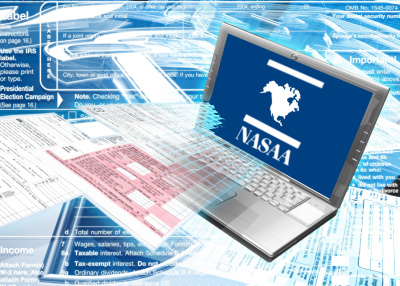 In late December of last year, the North American Securities Administrators Association (NASAA) launched, what it refers to, as its Electronic Filing Depository (EFD) system. The EFD system is designed to allow users to submit certain required “blue sky” notice filings in connection with exempt securities offerings to multiple states at once. Now if that does not seem like a big deal to you, then you probably don’t have to make these filings very often (or at all). For those of you who are like me, and who have had to file countless paper based notice filings, I am sure you will understand how monumentally more efficient even the most basic of electronic filing systems can potentially be.
In late December of last year, the North American Securities Administrators Association (NASAA) launched, what it refers to, as its Electronic Filing Depository (EFD) system. The EFD system is designed to allow users to submit certain required “blue sky” notice filings in connection with exempt securities offerings to multiple states at once. Now if that does not seem like a big deal to you, then you probably don’t have to make these filings very often (or at all). For those of you who are like me, and who have had to file countless paper based notice filings, I am sure you will understand how monumentally more efficient even the most basic of electronic filing systems can potentially be.
Section 18(b)(4) of the Securities Act of 1933 provides that an offering of “covered securities” (as defined therein) will be exempt from the registration requirements of state-level “blue sky” securities laws. Among these “covered securities” are private placements made under Rule 506 of Regulation D. Now while exempt from registration requirements, states can (and do) still ask issuers to make certain “notice filings,” and to pay certain filing fees, with respect to offerings of covered securities if any of the purchasers reside within the state. Typically states require issuers to file a hardcopy of the “Form D” filed electronically with the SEC in connection with the offering, together with a fee that typically ranges between $100 and $500.
Sounds simple enough right? Unfortunately it isn’t. Many states have their own idiocentric rules and regulations regarding how and where these notice filings are made. For example, some states require the submitted Form D to have an original signature of an officer of the issuer, some require the transmittal letter to identify the aggregate offering amount and whether any brokers were used, etc. Then there is New York which is the worst of the worst, requiring multiple documents to be filed between three separate agencies. As if this weren’t bad enough, the notice filing/fee requirements of many states are not easily located. I cannot tell you how many hours I have spent combing through various blue sky regulations just to determine the filing requirements. Not to mention the fact that you have to constantly go back to the regulations to see if any changes have been made (e.g. Delaware, who has never had a filing fee in connection with a Rule 506 notice filing, instituted a fee effective as of January 1, 2015).
located. I cannot tell you how many hours I have spent combing through various blue sky regulations just to determine the filing requirements. Not to mention the fact that you have to constantly go back to the regulations to see if any changes have been made (e.g. Delaware, who has never had a filing fee in connection with a Rule 506 notice filing, instituted a fee effective as of January 1, 2015).
Needless to say, when conducting a multi-state offering on behalf of an issuer, the related state “blue sky” compliance can be extremely tedious and fraught with landmines for the inexperienced. This is why I am so excited about the introduction of the EFD system. Not only will it provide for a more efficient filing process by significantly reducing the time and costs associated with preparing and transmitting traditional paper filings, but it will help to standardize the filing rules among the states. Other benefits of the EFD include: (a) allowing a filer to follow the status of each state’s review of submitted filing materials and to respond quickly to any noted deficiencies that arise; (b) providing an electronic receipt as proof of compliance (which has been traditionally difficult to get from many states); and (c) allowing investors and the general public to view all “blue sky” filings made by any issuer (to the extent submitted through the EFD).
Now there are certain limitations of the current EFD that should be noted:
- States must opt in; Limited number of participating states. As current “blue sky” regulations generally are not draft in a manner that readily allows for the acceptance of filing materials from the EFD, states that want to participate in the EFD will have to modify the applicable state regulations to essentially opt into this service. To make the process easier, NASAA has developed certain model rules to assist in implementing such modification. As of the date of this post, the District of Columbia, Puerto Rico, the U.S. Virgin Islands and the following 37 states are accepting EFD filed materials in connection with Rule 506 offerings: Alabama, Alaska, Arkansas, Colorado, Georgia, Hawaii, Idaho, Illinois, Indiana, Iowa, Kansas, Kentucky, Maine, Maryland, Missouri, Montana, Nebraska, Nevada, New Hampshire, New Jersey, New Mexico, North Dakota, Ohio, Oklahoma, Pennsylvania, Rhode Island, South Carolina, South Dakota, Tennessee, Texas, Utah, Vermont, Virginia, Washington, West Virginia, Wisconsin, and Wyoming.
- Limited Functionality. The functionality of the current version of the EFD only allows for the filing of a copy of the Form D and the paying of a filing fee in connection with a Rule 506 offering. Accordingly, if a particular state requires additional information pursuant to their respective “blue sky” regulations (e.g. separate Form U-2 “consent to service of process,” copies of offering materials, etc.) such information will still need to be provided to the appropriate state agency. It is anticipated that the functionality of the EFD will be significantly expanded in the future to allow for the submission of additional filing materials/the filing of notice materials with respect to other types of offerings, but for now it is limited to the forgoing.
- Additional Fee. In addition to the filing fee to be collected for each applicable state, there is an additional $150 EFD use fee for each offering. This fee covers the issuer’s initial Form D filing and all amendments/renewals of such filings made through the EFD for that offering.
- Interaction with Existing Systems. The EFD is not the first electronic platform for submitting “blue sky” notice filing materials. Several states have already initiated their own electronic platforms for submission of required securities filings of that state (e.g. California’s Self-Service DOCQNET Portal). Assuming that the EFD will eventually become THE method for submitting “blue sky” filings as intended, states that have their own such platforms will need to either abandon those systems or find a way to make them work in conjunction with the EFD.
 The EFD is clearly limited and in no way perfect but a centralized “blue sky” filing platform is LONG overdue. I believe that the launch of the EFD represents a significant step toward standardizing “blue sky” filings and I intend to utilize it as much as possible. For those looking to do the same, NASAA has put together a training video for using the EFD.
The EFD is clearly limited and in no way perfect but a centralized “blue sky” filing platform is LONG overdue. I believe that the launch of the EFD represents a significant step toward standardizing “blue sky” filings and I intend to utilize it as much as possible. For those looking to do the same, NASAA has put together a training video for using the EFD.
Before I leave this topic, I would like to quickly touch on the somewhat heated subject of federal “pre-emption” with respect to certain offerings of securities. For those that do not know, the SEC has proposed that, in connection with the forthcoming “Regulation A+” offering rules, state “blue sky” filings for these offerings be pre-empted all together. The resonating behind this move is to help streamline the offering process for these types of offerings by avoiding the inevitable patchwork of state “blue sky” notice filing regulations that have plagued other offerings (e.g. Rule 506 offerings). Obviously many of the states, and NASAA, have argued vehemently against the need for pre-emption (and the right of the SEC to proscribe it). In fact, in response to the SEC’s reasoning regarding efficiency, NASAA has argued that it believes the new EFD will streamline the process making federal pre-emption unnecessary.
I agree that the new EFD could be used to make any required notice filing easier as argued by NASAA but the real question is why is the filing necessary at all? To be perfectly honest, I have never actually understood the need for sending copies of a filed Form D to a state agency. Maybe I am just cynical, but I really believe that these notice filings just get tossed in a giant box somewhere and are never looked at. As a result, the only reasoning I can see for requiring them is to allow states to collect the associated filing fees. If that is the case, I say bring on federal pre-emption! Not just for Regulation A+ offerings but for all “covered securities.” If the state’s are worried about their fees then let them collect a fee and turn the EFD into a centralized payment processing site instead of a document depository. Just don’t make issuers (and attorney’s like me) to waste time submitting useless documentation. As I see it, this would make everyone happy. Especially attorneys like me who have had to adhere to mind numbing protocol to submit required notice filing documentation.
submitting useless documentation. As I see it, this would make everyone happy. Especially attorneys like me who have had to adhere to mind numbing protocol to submit required notice filing documentation.
In a world dominated by digital communications, the current “multiple state” filing process is laborious, costly and a deterrent to issuers. While the EFD will help to streamline the filing process, this may be a situation of too little too late by NASAA as the SEC has admirably taken matters into its own hands by introducing the concept of pre-emption. Times change and sometimes institutions and processes need to change too. Until that day however, at least we now have the EFD to make our lives a little easier.

Anthony, this is very informative, but it would be super-helpful if you could call up Delaware & New York and convince them to take part in the NASAA EFD program. Preferably by, oh, say, Thursday.
Thanks!
Ha, sure I will get right on that … any other miracles you need? 😉